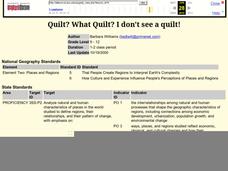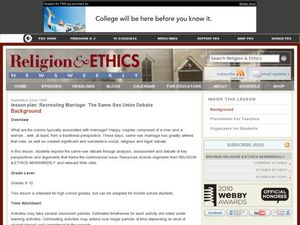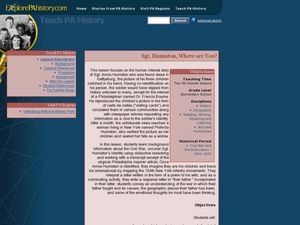New York City Department of Education
Colonial America and The American Revolution
How did the founding of the American colonies lead to a revolution? Use the essential question and sample activities to guide learners through a series of history lessons. Additionally, the packet includes effective strategies to...
US Institute of Peace
What Does It Take to Be a Peacebuilder?
Is the spirit of peacebuilding already inside you? Scholars take a closer look at the characteristics of peacebuilders, past and present, in instructional activity 13 of a 15-part series. Individuals identify common traits of...
Curated OER
Canadian Symbols
Students discover the ideals of Canada by analyzing its symbols. In this Canadian culture lesson, students identify the symbols that established the U.S. as its own nation and compare them to important Canadian symbols....
Curated OER
COLONIAL FLYERS/TRAVEL BROCHURES TO THE COLONIES
Students investigate concepts of history and geography in this activity. They create travel brochures for travelers who are crossing the Atlantic Ocean to populate the colonies of early America. The brochure has topographical information...
Curated OER
Community Centered Neighborhood Development
Ninth graders explore the culture of the neighborhood. In this Social Studies activity, 9th graders examine the different development sites in their community. Students research the zoning regulations.
Curated OER
Andy Warhol and Silkscreen Pop Art
Students explore art history by researching famous paintings on-line. In this Andy Warhol lesson, students discuss who Warhol was, his impact on popular art and methods of painting. Students examine his use of silk screen printing and...
Novelinks
The Hitchhiker’s Guide to the Galaxy: Herber Readiness Activity
What does it mean to be alone and isolated? What would you do if you were all alone in a strange place? Kids ponder these questions as they prepare to read Douglas Adams' The Hitchhiker's Guide to the Galaxy.
Curated OER
Glimpses of Japan: Picture books are an avenue to geographical knowledge
Student gains insight into the culture of Japan. They articulate the main ideas and supporting details, also they create a "glimpse of Japan" with an illustrated and written summary of the main idea and four supporting details from the...
Curated OER
Quilt? What Quilt? I Don't See a Quilt!
Students analyze maps and cultures of major cities in the state of Arizona and designate different regions within the state according to geography and economy.
Curated OER
Flood Control: Environmental History
Students examine the painting, Spring on the Missouri. They role-play and discuss floods and flood control from the views of an environmental lobbyist and a farmer.
Curated OER
Perception and Observation
Students use common and unusual objects to make observations of details, design, and functionality. They describe and draw each object while working in small groups. The differences between observation and perception is covered as part...
Curated OER
Recreating Marriage: The Same-Sex Union Debate
A debate continues regarding same-sex marriage as a constitutional right. This lesson requires learners to define marriage then formulate an argument that reconstructs the national debate perspectives. Many standards are addressed but a...
Curated OER
Indigenous People Day
Do you know why we celebrate the International Day of the World's Indigenous People? Did you even know we celebrate this day? After reading a short passage about this international celebration, scholars answer true or false questions,...
Curated OER
Types of Irony: Examples & Definitions
Isn’t it ironic that many situations labeled ironic aren’t? Properly labeled examples of verbal, dramatic, and situation irony are defined and illustrated in a short, animated video that uses passages from literary works as models. The...
Curated OER
Sgt. Humiston, Where are You?
Students become familiar with the events of the Civil War. In this identification lesson, students use deductive reasoning to understand how the deceased soldier was identified. Students view primary documents for information...
Curated OER
Archaeological Detectives
Students, in groups, examine in depth one aspect of forensic archaeology to determine the skeleton's age, gender, and possible cause of death. To do so, students must first explain what is involved in each aspect of forensic archaeology.
Curated OER
Poetry - Landscape, Comparison, and Critical Response
Students compare and evaluate landscape poetry. In this poetry lesson plan, students read poetry by Owen Sheers that describes place/landscapes. They read and compare two similar poems before looking at visual images related to the...
Curated OER
Sex Education
Seventh graders take a survey to determine their attitudes toward sexuality. In groups, they identify female and male reproductive organs and develop a list of secondary sex traits during puberty. They also discuss the stages of the...
Curated OER
UN Conference on the Impact of Civil War on the Common Person
Students simulate understanding of conflict or civil war they researched, and role play character they developed at model UN conference on the impact of civil war on the common person.
Curated OER
Rites of Passage
Students explore coming of age ceremonies. In this rites of passage lesson, students research spiritual, religious, and secular child and adolescent rites of passage rituals. Students design personal rites of passage.
Curated OER
School Redesign and Multiple Intelligences
Students examine their own intelligence to find areas of strength after studying the multiple intelligences. In this diverse learning styles lesson plan, students analyze how the school environment fosters or fails students of...
Curated OER
The Mad Pursuit Search for the Structure of DNA
Students complete a variety of activities as they study the historical story of Rosalind Franklin not receiving credit for her contributions in discovering the structure of DNA.
Curated OER
The Armenian Genocide: The American Ambassador in Constantinople
Students analyze America's reaction to the Armenian Genocide. They write a journal response, read and discuss text, compare/contrast reactions around the world to the Armenian Genocide and the genocide in Rwanda, and write an essay.























